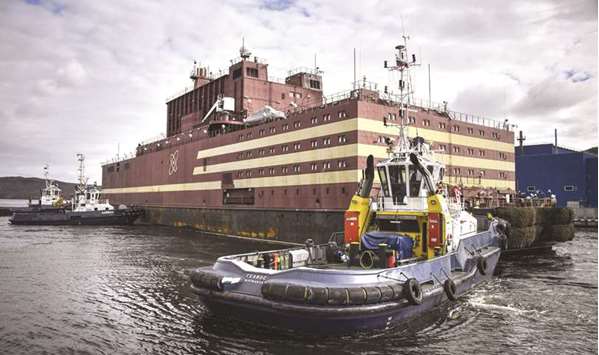Russia has unveiled the world’s first floating nuclear power station at a ceremony in the port of the far northern city of Murmansk where it will be loaded with nuclear fuel before heading to eastern Siberia.
Built in Saint Petersburg, the Akademik Lomonosov arrived in Murmansk on Thursday where it was moored in the port before being presented to the media yesterday.
Detractors have derided it as a “Chernobyl on ice”.
Constructed by the state nuclear power firm Rosatom, the 144m by 30m (472’ by 98’) ship holds two reactors with two 35MW nuclear reactors that are similar to those used to power icebreaker ships.
Rosatom chief Alexei Likhachev hailed the new power station as “a new world first”, which he said “underlines the undoubted leading role of Rosatom and the Russian nuclear energy sector on the global agenda”.
“I hope today will be a symbolic day for the Arctic,” Likhachev said, adding that Rosatom “is setting a trend, a demand for medium-capacity nuclear facilities, mobile facilities, for many decades ahead”.
The 21,000-tonne barge will be towed in the summer of 2019 to the port of Pevek in the autonomous Chukotka region in Russia’s extreme northeast, 350km (217 miles) north of the Arctic Circle.
As Russia is forced to push further north into the Arctic in the search for oil and gas, it needs electricity in far-flung locations.
“The idea is to have low-capacity, mobile power plants that can be used in the Russian Arctic where large amounts of electricity aren’t needed” and the construction of a conventional power station would be complicated and costly, said Sergei Kondratyev at the Institute for Energy and Finance in Moscow.
“The alternatives are coal, gas and diesel. But diesel is very costly,” he said, while the gas needs to be delivered as liquefied natural gas or LNG.
The barge can produce enough electricity to power a town of 200,000 residents, far more than the 5,000 who live in Pevek, Russia’s northernmost town.
It will be primarily used to power oil rigs.
Vitaly Trutnev, in charge of the construction and operation of floating nuclear power stations at Rosatom, said that such units would “supply electricity and heat to the most remote regions, supporting also growth and sustainable development”.
He said use of such floating reactors can save 50,000 tonnes of carbon dioxide emissions per year.
The barge had initially been scheduled to be fuelled in Saint Petersburg, but that work was moved to Murmansk instead due to concern in countries along the Baltic Sea.
Trutnev has insisted that the barge has “the latest security systems and should be one of the safest nuclear installations in the world”.
Activists at the environmental group Greenpeace are not convinced and call for international monitoring.
They fear that the Akademik Lomonosov could become a “nuclear Titanic” or a “Chernobyl on ice”, 32 years after the Soviet nuclear disaster.
Greenpeace Russia’s Rashid Alimov said that accidents are possible at all nuclear power plants, but that the barge “will be especially sensitive to storms, environmental phenomena and threats such as terrorism”.
He said a shift to more numerous small reactors would pose risks for proliferation of nuclear material.
Greenpeace nuclear expert Jan Haverkamp noted that the Akademik Lomonosov is being fuelled near Murmansk, a city of 300,000, before being towed across the Arctic.
“Its installation in the tough environment of the Russian Arctic will pose a constant threat for residents of the north and the Arctic’s pristine nature,” said Haverkamp.

The Akademik Lomonossov being towed to the Atomflot moorage of the Russian northern port city of Murmansk.


